
Helping people connect with loved ones, no matter where they are
Designing an app that helps people navigate the intricacies of long-distance relationships — whether it’s with a romantic partner, close friends, or family members.
TIMELINE
May – July 2024
ROLE
Product Designer
TEAM
Solo project
TOOLS
Figma
FigJam
Procreate
SKILLS
Interaction Design
Visual Design
Design Systems
User Research
CONTEXT
I've moved around a lot, and as a result, my friends are scattered all over the world. This means some friendships fade away over time unless we actively maintain them through scheduled calls, catching up, and sending updates. But shouldn't interacting with loved ones feel natural rather than like work?
OUTCOME
I created inner as a personal project to explore meaningful ways of interacting with loved ones who live far away.
When I started researching the difficulties surrounding long-distance relationships, I immediately realised that a lot of resources are focused on long-distance romantic relationships.
This revelation wasn't surprising, but it sparked some questions: Beyond physical intimacy, what unique challenges do long-distance romantic relationships face? Do these challenges overlap with those in long-distance friendships and other relationships? Might there be a universal solution?
Trying to get a deeper understanding of these questions, I interviewed four people who have long-distance romantic partners as well as long-distance friends.

My main take-aways from these conversations was that, no matter the type of long-distance relationship, it usually feels different/harder than a proximal relationship primarily for three reasons:
Scheduling
Coordinating communication in long-distance relationships and friendships is significantly hindered by time zone differences and unpredictable schedules, requiring flexible and adaptive time management strategies.
Emotional Impact
The complicated scheduling and lack of face-to-face contact often leads to heightened feelings of insecurity and guilt, as well as feelings of emotional disconnect. On the other side, having a partner or friend who lives far away makes people value and deeply appreciate time spent together.
Findings Ways to Connect
Maintaining meaningful connections in long-distance relationships and friendships requires proactive efforts to overcome communication barriers and keep interactions engaging, often necessitating thoughtful planning and consideration of each individual's communication preferences and emotional needs to foster closeness and sustain the relationship over time.

I wanted to create a solution that would not just offer practical help, but also create a feeling — of warmth, connection, shared understanding.
The early prototype of inner focused on the idea of sharing everyday moments with loved ones.
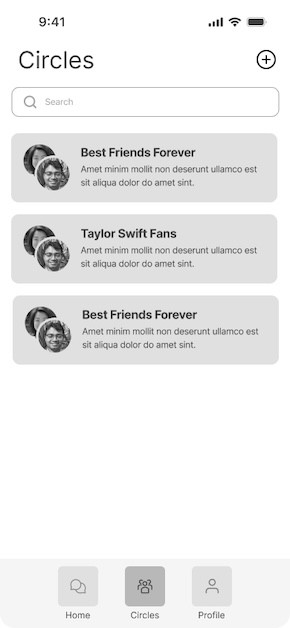
Circles
Users could create Circles with loved ones – safe spaces where they could chat, reminisce, and plan.

Moments
Within Circles, users could share Moments with their loved ones – life events (like attending the concert of their favourite musician) or simply snippets of their day (like a photo from their lunch break spent at a park).
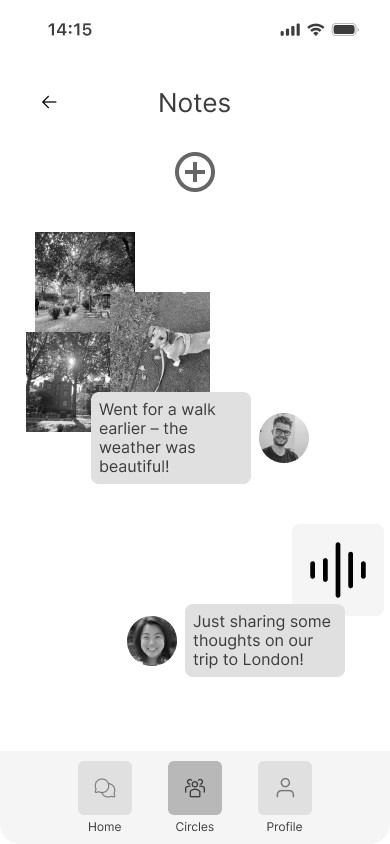
Notes
They could also send Notes to loved ones whenever they were thinking about them. Unlike a standard chat feature, Notes are a space to share something that made you think of a loved one and do not require a reply.
However, after user-testing the prototype with a few people, it became clear that the solution deviated from the original mission of helping friends and romantic partners navigate the difficulties of staying in touch despite the distance. Moreover, there were a few user experience issues.
While I focused on the idea of being able to share more of your everyday life and special moments with loved ones, there are many other challenges of LDRs that I missed. For example, people struggle with scheduling difficulties involved in LDRs – what kind of solution could address them?
inner v2: Scheduling dates and sharing memories
For the second concept, I focused on the challenge of scheduling time with a loved one and sharing experiences beyond a catch-up call.
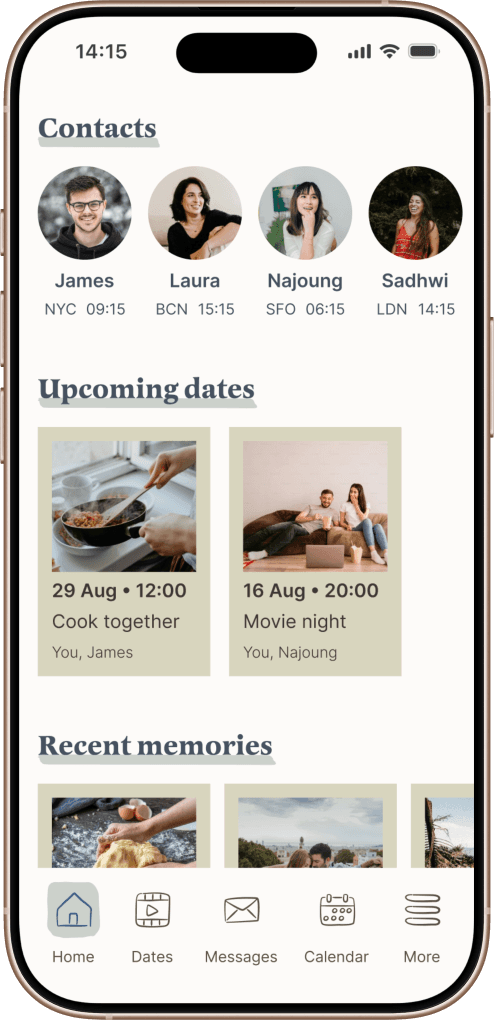
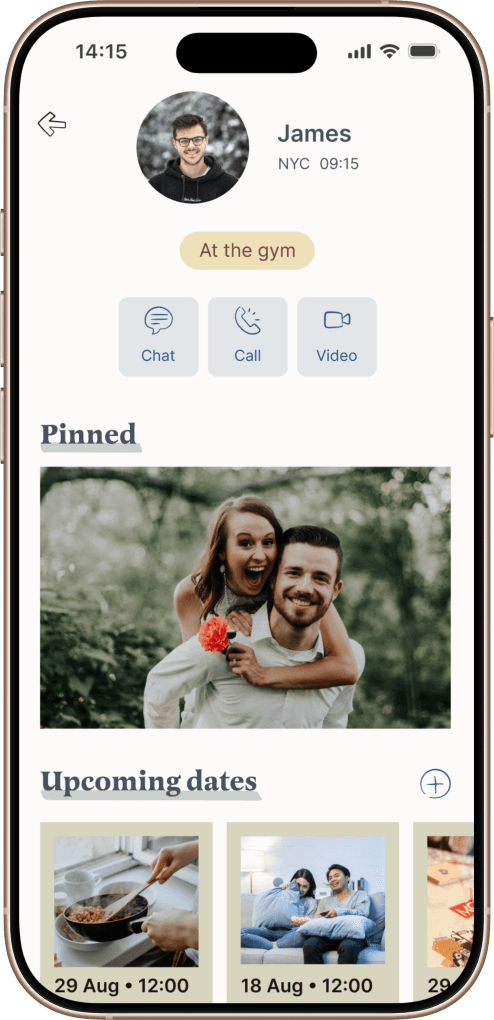
The profile screen gives you quick information about their timezone, current status (whether they are busy or available for a quick chat), as well as access to different ways to interact with a loved ones.
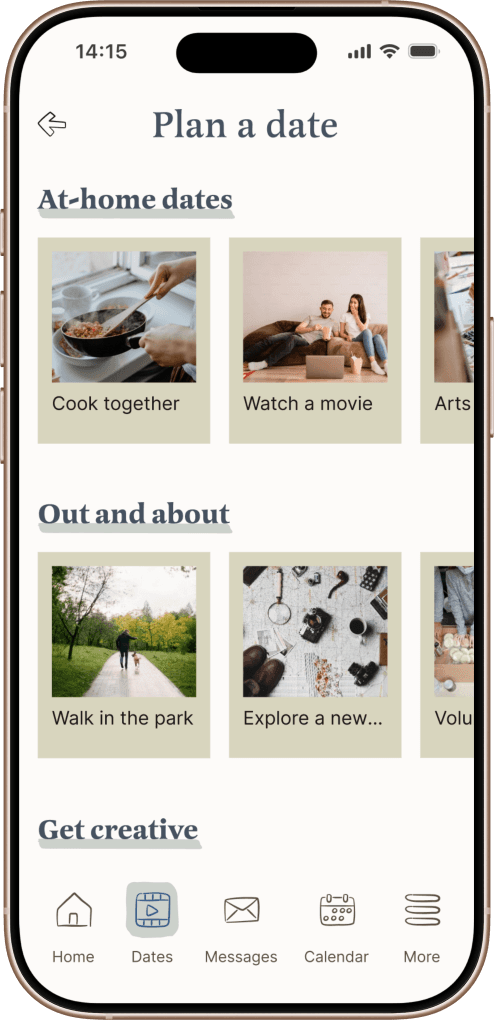
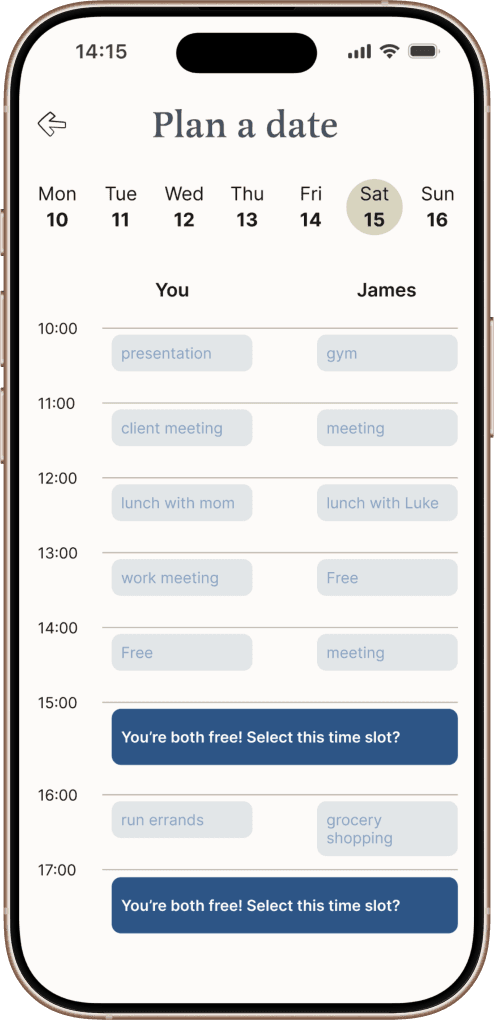
inner gives people suggestions for things to do together virtually so you can still share meaningful experiences despite the distance. The app also lets you share your calendar with loved ones and send them invites for dates and hangouts.


I still wanted to keep the idea of providing something that feels like a comforting space to feel connected to a loved one. I created a space to share Memories – pictures, voice notes, snippets from chats – to help people preserve anything that feels important to them.
Here's what I learned…
This project included a significant pivot: the initial concept did not go as I thought during user testing, and I had to switch gears in a very short amount of time. However, this turned out to be a blessing in disguise: once I realised that it was taking me in the opposite direction from the problem space I had identified, I quickly saw that there were more promising directions that aligned more closely with the goal and the HMW. In retrospect, here are some things I wish I could have told myself:
Don’t be afraid to change directioN
Especially if that’s the most logical next step! This is scary to do when working with a deadline, but it’s a better option than keeping working on an idea that you know isn’t right.
Don’t get too attached to one idea
You will likely have to change it. From the beginning, I was kind of set on the idea of creating a safe space for friends to share snippets of their life – it was hard to let go of even if it wasn’t clear how it would address the problem I was trying to solve.
Keep in mind the problem space and HMW questions
Revisit them frequently. Thinking about my design process more strategically from the beginning would’ve saved me a lot of time and panicking.